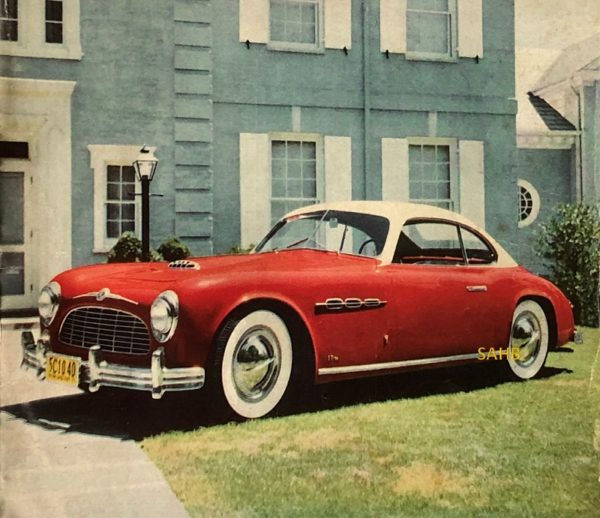
In the December 1952 issue of Speed Age this car was described as the “World’s Most Exclusive Automobile.” The builders, two years before, were Italmeccanica in Turin, one of many small workshops in that city who could together turn out remarkable prototypes such as this one.
The car was the brainchild of American investors, including Richard Rush, Bob Ackerman and Tony Pompeo, the sports car driver and importer of Italian “Etceterinis” such as SIATA, Bandini, Stanguellini, Moretti and Ermini.
The idea was to produce a car which combined the excellent chassis, suspension and luxurious coachwork of European sports cars with the simplicity and ease of maintenance of an American drivetrain. Richard Rush admitted that the finest European sports car in the early 1950s was the Ferrari. But he pointed out that ‘It is not a simple car. You cannot drive into a garage and say, “Fix it!”’.
The Italmeccanica chassis was tubular, with thick parallel rails and cross members. Rush claimed that it was possible to jack the car up near a particular wheel and lift the entire side of the car. This rigidity would also give the best roadholding and provide strong anchor points for the planned four-wheel torsion-bar suspension. This did not come to fruition. All the systems tried gave too little springing, and the design was changed to Dubonnet-type independent suspension at the front and conventional leaf springs at the rear.
The IT160 was designed to take Ford or Cadillac engines, and was tested with both. Either one drove through a Borg Warner competition clutch and a standard Ford transmission with overdrive. The differential, rear axle and brakes were said to be 1950 Ford – but the assembly was claimed to be “the famous Allard de Dion differential [made up] largely from Ford parts.” It is almost certain that there was no de Dion: an example sold in 2010 had a live rear axle. Almost all accessories were standard American, including switches, lights and fuse box.
The body was said to have been made by Stabilimenti Farina. Soon after, the prototype was restyled by Bud Unger and fitted with 1949 Plymouth bumpers and flipper hubcaps (the flipper is the single bar across the centre, popular as an aftermarket custom accessory before and after World War II). He also gave it a two-tone Tuscan Tan and Chariot Red paint job. This is the form in which it appears in our Snapshot, beautiful enough to win prizes at six auto shows in 1951 and 1952.
Total car weight was just over 2,450 pounds. With around 200 horsepower, the car would have been lively for its time, with an estimated top speed of 140mph and 0-60 in 10 seconds.
This was a project that sadly never bore fruit – but at least one example remains. Powered by a Cadillac flathead V-8 and proudly sporting an Italmeccanica Torino badge (including the words “Derivato Ford”) at the front and a Farina badge at the rear, it was sold by RM Sotheby’s in 2010 for $143,000.
Photo courtesy of The Richard Roberts Archive.







Leave a Comment